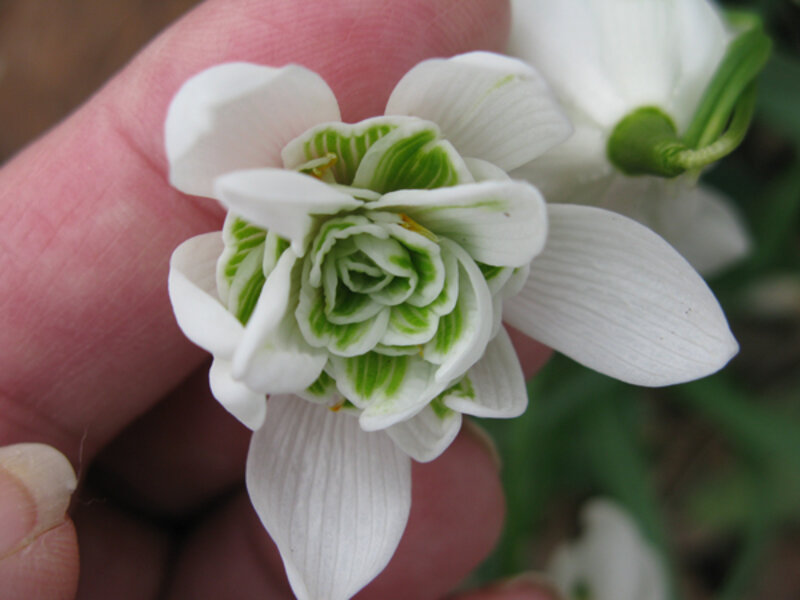A blizzard of snowdrops
Loading...
After a miserable winter, there is nothing as enticing as the first blossom of spring. And in my garden, the first ones to appear are the honey-scented snowdrops, Galanthus nivalis.
In years when we experience a very mild winter, those sweet, tiny dangling milk-white flowers sometimes wrestle their way through the frozen soil and shine in my garden as early as the last week of February. This year, however, we had a snow pack. So I figured my plants were still asleep.
Then last week, the temps soared into the mid-50s, the snow melted, and, to my total amazement, I found clumps of snowdrops in full bloom all over the yard.
Although I have always found them charming, I never really thought much about these tiny bulbs – that is, until last year. Galanthophilia (collecting snowdrops) struck me when I visited a friend’s incredible woodland garden in Iowa.
His is a landscape blessed with numerous mature trees that provide the perfect habitat for his vast collections of many rare and wondrous plants. And one of the plants he collects is snowdrops.
While meandering along his neatly mulched pathways, I saw several fine examples of distinctly unusual snowdrops. One look at those virginal, white-tipped spears emerging from the stark earth, and, as much as I hate to admit it, I was hooked on yet another plant.
Of course, there was the double form, readily available, G. nivalis ‘Flore Pleno’ [see second photo above]. But I also saw the much treasured ‘Lady Elphinstone’, a double flowering nivalis with buttery yellow inner petals, ‘Merlin’ which is popular because of its all-green petals, 'Magnet’, a vigorous bunch, with large blooms on very long flower stalks, and ‘Scissors’, so named because the green spots on the inner petals supposedly look like tailor’s shears – takes a bit of imagination, but it’s there.
White Gold – Britain’s love of Snowdrops
In England, nothing stands between a true galanthophile, or snowdrop fancier, and the object of his or her obsession. In late winter, thousands of snowdrop lovers visit British gardens whatever the weather to admire these tiny, bell-shaped flowers. They hold “snowdrop extravaganzas," “soup and snowdrop days,” and “galanthus galas” where truly rare snowdrops – such as this year’s sensation, the “orange” colored G. elwesii ‘Anglesey Orange Tip’ – are bought and sold.
These fanciers spend their winters down on their hands and knees on the frozen ground, peering at these small white flowers! They revel in the flower’s beauty, looking for the slightest difference between a light fleck of color and a solid band of green, and whether the leaves wrap round each other or stand apart.
These are true snowdrop fashionistas!
Subtle distinctions
Truth be told, snowdrop flowers are all very similar – either single or double. However, the main differences are in the number, location, and color of the green markings. These markings can be very small, very large, twin, or even triple marked, and occasionally on the outer petals, as well. And in some very rare cases, not green but yellow.
And although the flowers are not showy, Galanthus spp. are exceptionally hardy, flourishing even in Zone 3 (-40° F).
Snowdrops are a notoriously promiscuous bunch: Plant them close to one another, and left to their own devices, they can produce some rather surprising offspring.
There is always the feeling that one may just discover something special in that next patch, for among the 300 or so listed cultivars, few have been deliberately bred. Most come about by serendipity, discovered by some sharp-eyed galanthophile down on his or her knees on the cold earth examining a clump of snowdrops on a blustery winter’s day.
For the most part, gardeners plant snowdrops in the fall, because that’s when they are offered in most garden centers and major catalogs. But for you to be successful, these bulbs must be “fresh”, as they have a very short shelf life. So it’s best not to buy bulbs that have been sitting around for a time in a warm environment.
For true success, snowdrops are best planted “in the green” – that is, immediately after flowering, when the leaves are still present. At those times, just lift established clumps after flowering, split the clump in two, replant, and water well.
Most snowdrops prefer woodland conditions – a moist, humus-rich soil, under deciduous shrubs or among dormant perennials. Every three years or so, divide snowdrops immediately after flowering.
Betty Earl is one of nine garden writers who blog regularly at Diggin' It. She's the author of “In Search of Great Plants: The Insider’s Guide to the Best Plants in the Midwest.” She also writes a regular column for Chicagoland Gardening Magazine and The Kankakee Journal and numerous articles for Small Gardens Magazine, American Nurseryman, Nature’s Garden, and Midwest Living Magazine, as well as other national magazines. She is a garden scout for Better Homes and Gardens and a regional representative for The Garden Conservancy.
-----
To read more by Betty Earl, click here. For more Monitor gardening, see our main gardening page and all the posts of Diggin' It (scroll down to see more). Both have new URLs, so we hope you'll bookmark them and return.






